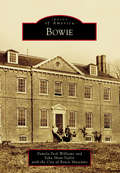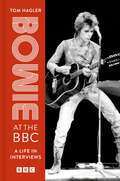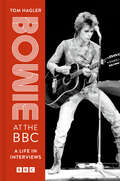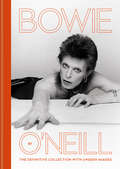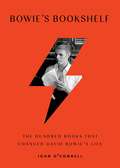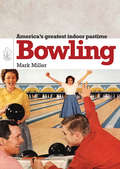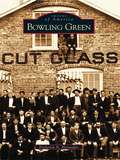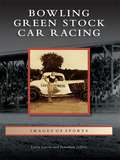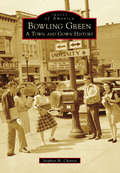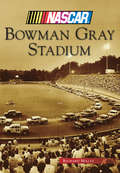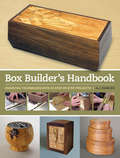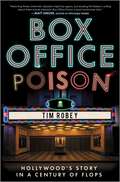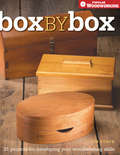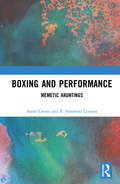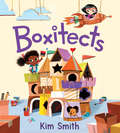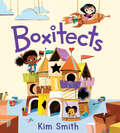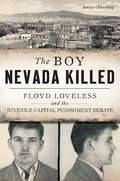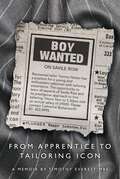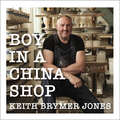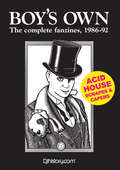- Table View
- List View
Bowie (Images of America)
by City of Bowie Museums Pamela Peck Williams Yoku Shaw-TaylorNestled in the heart of Prince George�s County, the city of Bowie has grown from a Colonial farming area to become one of Maryland�s largest cities. Its rich history is intertwined with those of the railroad, early tobacco culture, the rise of suburbia, and Thoroughbred racing. Belair Mansion and Stable bred some of the 20th century�s most brilliant racers, including two Triple Crown winners raced under the Belair colors. The Belair Mansion and Stable remain today as two of Thoroughbred racing�s most historic places. Built on the railroads, the city�s birthplace was Huntington City. At the heart of Huntington was Bowie Station, named for Maryland governor Oden Bowie, an important figure in the presence of the railroad in the area. Today, the city of Bowie is a growing, vibrant, and diverse city, incorporating almost 400 years of history in its story. Bowie is a true American hometown where the present celebrates the past every day.
Bowie at the BBC: A life in interviews
by David Bowie Tom HaglerThe life of an icon, in his own words.David Bowie had a unique relationship with the BBC, making more appearances on 'the beeb' than any other broadcaster throughout his career. An anonymous pre-fame teenager, a blossoming starlet, a white-hot rock star and a veritable elder statesman of pop: the BBC had the inside scoop on it all.In this fascinating collection of BBC television and radio transcripts, Bowie's life story is told in his own words, across more than 35 appearances spanning over forty years. Each provides an illuminating snapshot of moments in a remarkable career. But read together, they offer a completely new take on Bowie himself, a first-person look at the rise and rise of a star.Compiled and guided by David Bowie expert and BBC journalist Tom Hagler, Bowie at the BBC is the complete story of an incredible life lived on the airwaves.
Bowie at the BBC: A life in interviews
by David Bowie Tom HaglerThe life of an icon, in his own words.David Bowie had a unique relationship with the BBC, making more appearances on 'the beeb' than any other broadcaster throughout his career. An anonymous pre-fame teenager, a blossoming starlet, a white-hot rock star and a veritable elder statesman of pop: the BBC had the inside scoop on it all.In this fascinating collection of BBC television and radio transcripts, Bowie's life story is told in his own words, across more than 35 appearances spanning over forty years. Each provides an illuminating snapshot of moments in a remarkable career. But read together, they offer a completely new take on Bowie himself, a first-person look at the rise and rise of a star.Compiled and guided by David Bowie expert and BBC journalist Tom Hagler, Bowie at the BBC is the complete story of an incredible life lived on the airwaves.
Bowie at the BBC: A life in interviews
by David Bowie Tom HaglerThe life of an icon, in his own words.David Bowie had a unique relationship with the BBC, making more appearances on 'the beeb' than any other broadcaster throughout his career. An anonymous pre-fame teenager, a blossoming starlet, a white-hot rock star and a veritable elder statesman of pop: the BBC had the inside scoop on it all.In this fascinating collection of BBC television and radio transcripts, Bowie's life story is told in his own words, across more than 35 appearances spanning over forty years. Each provides an illuminating snapshot of moments in a remarkable career. But read together, they offer a completely new take on Bowie himself, a first-person look at the rise and rise of a star.Compiled and guided by David Bowie expert and BBC journalist Tom Hagler, Bowie at the BBC is the complete story of an incredible life lived on the airwaves.
Bowie at the BBC: A life in interviews
by David Bowie Tom HaglerA LOUDER THAN WAR BOOK OF THE YEAR'A unique insight... An excellent companion for both the casual and obsessive Bowie fan'Louder Then WarThe life of an icon, in his own words.David Bowie had a unique relationship with the BBC, making more appearances on 'the beeb' than any other broadcaster throughout his career. An anonymous pre-fame teenager, a blossoming starlet, a white-hot rock star and a veritable elder statesman of pop: the BBC had the inside scoop on it all.In this fascinating collection of BBC television and radio transcripts, Bowie's life story is told in his own words, across more than 35 appearances spanning over forty years. Each provides an illuminating snapshot of moments in a remarkable career. But read together, they offer a completely new take on Bowie himself, a first-person look at the rise and rise of a star.Compiled and guided by David Bowie expert and BBC journalist Tom Hagler, Bowie at the BBC is the complete story of an incredible life lived on the airwaves.
Bowie by O'Neill: The definitive collection with unseen images
by Terry O'Neill'This is not just another Bowie book. This, it's fair to say, is THE Bowie book... Essential for any fan.'THE SUNDAY TELEGRAPH'A truly sparkling collection.'THE DAILY MAIL'More than 500 photos of immense breadth and depth.'VOGUEChosen as one of Vogue's Best David Bowie Books.This book is the breathtaking result of iconic photographer Terry O'Neill's creative partnership with David Bowie that spanned over a number of years, including images published here for the first time.Containing rare and never-before-seen photographs, their work together includes images from the last Ziggy Stardust performance, recording sessions for Young Americans and the renowned studio portraits for Diamond Dogs - plus live shows, film shoots, backstage moments and more. With more than 500 photographs, this is the ultimate portrait of an inspiring, challenging and ever-changing artist.
Bowie by O'Neill: The definitive collection with unseen images
by Terry O'NeillThis book is the breathtaking result of iconic photographer Terry O'Neill's creative partnership with David Bowie that spanned over a number of years, including images published here for the first time.Containing rare and never-before-seen photographs, their work together includes images from the last Ziggy Stardust performance, recording sessions for Young Americans and the renowned studio portraits for Diamond Dogs - plus live shows, film shoots, backstage moments and more. With more than 500 photographs, this is the ultimate portrait of an inspiring, challenging and ever-changing artist.
Bowie's Bookshelf: The Hundred Books that Changed David Bowie's Life
by John O'ConnellNamed one of Entertainment Weekly&’s 12 biggest music memoirs this fall. &“An artful and wildly enthralling path for Bowie fans in particular and book lovers in general.&” —Publishers Weekly (starred review) &“The only art I&’ll ever study is stuff that I can steal from.&” ―David Bowie Three years before David Bowie died, he shared a list of 100 books that changed his life. His choices span fiction and nonfiction, literary and irreverent, and include timeless classics alongside eyebrow-raising obscurities.In 100 short essays, music journalist John O&’Connell studies each book on Bowie&’s list and contextualizes it in the artist&’s life and work. How did the power imbued in a single suit of armor in The Iliad impact a man who loved costumes, shifting identity, and the siren song of the alter-ego? How did The Gnostic Gospels inform Bowie&’s own hazy personal cosmology? How did the poems of T.S. Eliot and Frank O&’Hara, the fiction of Vladimir Nabokov and Anthony Burgess, the comics of The Beano and The Viz, and the groundbreaking politics of James Baldwin influence Bowie&’s lyrics, his sound, his artistic outlook? How did the 100 books on this list influence one of the most influential artists of a generation? Heartfelt, analytical, and totally original, Bowie&’s Bookshelf is one part epic reading guide and one part biography of a music legend.
Bowling
by Mark MillerPopular in various forms the world over, bowling became one of America's favorite pastimes as early as the 1800s. Bowling rules were standardized in New York in 1895. But it wasn't until after World War II that bowling really swept the nation, and by the 1950s and '60s, bowling was ubiquitous in towns and cities small and large. Local and national competitions, television specials, and the Professional Bowlers Association helped fuel the fire. Soon, adults and children alike were participating in bowling on a regular basis, often in weekly leagues. Though popularity has waxed and waned over the years, today more than 95 million people count themselves as regular bowlers. Bowling expert Mark Miller traces the history of bowling in the United States in this colorful and concise exploration of bowling as both a sport and a leisure activity. From its ancient beginnings to the mid-century boom to today's bowling and entertainment centers, Miller captures the essence of bowling.
Bowling Green (Images of America)
by Frederick N. HonnefferThe Great Black Swamp may have slowed the settlement of northwest Ohio, but it couldn't stop a little town south of Toledo called Bowling Green. It blossomed into an agricultural gold mine with natural gas and oil booms that prospered the modest Wood County seat late in the Nineteenth Century. Now as the home of internationally known Bowling Green State University, the National Championship Tractor Pulling Competition, and the Black Swamp Arts Festival, this formerly uninhabitable swamp continues to attract its fair share of attention. In this pictorial history you will learn how Bowling Green beat the odds to become the city everybody wants to revisit.
Bowling Green Stock Car Racing (Images of Sports)
by Jonathan Jeffrey Larry UptonBowling Green became the city of speed immediately after World War II as America began its love affair with the automobile. Stock car racing took the city by storm in its inaugural season of 1951, drawing crowds of up to 7,000 in a city of only 18,000. Soon thereafter, the city attracted the Chevrolet Corvette assembly plant followed by the National Corvette Museum. Images of Sports: Bowling Green Stock Car Racing documents the history of stock car racing in Bowling Green and the emergence of the raceway at Beech Bend Park.
Bowling Green: A Town and Gown History
by Stephen M. CharterThe city of Bowling Green began as a small settlement on sand ridges of the Great Black Swamp. Through the efforts of determined citizens who tapped into a wealth of natural resources, it became a thriving community. Always looking for opportunities to promote their town, a group of local residents successfully campaigned to secure Bowling Green as the site of Bowling Green State Normal College. The community and college have worked together through the years to develop and strengthen a mutually beneficial relationship that continues to enrich the lives of its student population. Local businesses have provided entertainment and social venues, as well as goods and services to students, and Bowling Green State University has provided cultural and educational programs for residents. Collaborative initiatives have enabled the college and community to work together in order to improve life for the entire Bowling Green community.
Bowman Gray Stadium
by Richard MillerWith the sounds of engines roaring since 1949, Bowman Gray Stadium is NASCAR's oldest weekly race track. Named in honor of the former R.J. Reynolds CEO Bowman Gray, this quarter-mile track has been the host to many exciting racing moments. Bowman Gray Stadium showcases the rich history of many of the major racing dynasties, including members of the Petty, Earnhardt, and Allison families, and celebrates the races and traditions that have kept spectators and race fans coming week after week for over 50 years. Today, Bowman Gray Stadium's weekly racing tradition continues as part of the NASCAR Whelen All-American Series.
Box Builder's Handbook: Essential Techniques with 21 Step-by-Step Projects
by A. J. HamlerOur daily lives are full of boxes-some purely functional, others purely decorative, but most provide both beauty and a worthwhile purpose. There are many ways to make boxes; square, round, long, tall, turned or bandsawn. In the Box Builder's Handbook author A.J. Hamler presents some of the projects as introductions to specific box styles. Others are standalone projects, but most are an example of a box type, and as part of the project he offers tips and suggestions on how to use the project as a springboard to make additional boxes of this type. Follow the step-by-step instructions and diagrams to build the box of your choice, or build them all and learn a new skill with each new project. And as a bonus, every project in this book will make a great handmade gift for someone special.
Box Office Poison: Hollywood's Story in a Century of Flops
by Tim Robey***A NEXT BIG IDEA CLUB MUST-READ BOOK OF NOVEMBER 2024***"A wild success." — Publishers Weekly"A surefire hit." —Library Journal STARRED review"A brilliant star turn." —Andrew O&’HaganA riotous and revealing story of Hollywood&’s most spectacular flops and how they ended careers, bankrupted studios and changed film history."Failure fascinates, for all the reasons that success is a drag…&”From grand follies to misunderstood masterpieces, disastrous sequels to catastrophic literary adaptations, Box Office Poison tells a hugely entertaining alternative history of Hollywood, through a century of its most notable flops. What can these films tell us about the Hollywood system, the public&’s appetite–or lack of it–and the circumstances that saw such flops actually made? Away from the canon, this is the definitive take on these ill-fated, but essential celluloid failures.Robey covers a vast century of flops, including: Intolerance; Queen Kelly; Freaks; Sylvia Scarlett; The Magnificent Ambersons; Land of the Pharoahs; Doctor Dolittle; Sorcerer; Dune; The Adventures of Baron Munchausen; Nothing But Trouble; The Hudsucker Proxy; Cutthroat Island; Speed 2: Cruise Control; Babe: Pig in the City; Supernova; Rollerball; The Adventures of Pluto Nash; Gigli; Alexander; Catwoman; A Sound of Thunder; Speed Racer; Synecdoche, New York; Pan; and Cats.From Daily Telegraph film critic Tim Robey, this is a brilliantly fun exploration of human nature and stupidity in some of the greatest film flops throughout history.
Box by Box: 21 Projects for Developing Your Woodworking Skills (Popular Woodworking Ser.)
by Jim StackHone Your Woodworking Skills One Box at a Time When it comes to great woodworking projects, it's hard to beat boxes. Using a minimal amount of materials, you can craft wonderful gifts or items for sale. And it's a great opportunity to use those pieces of special wood you've been hoarding. The real trick to successful box-making is coming up with the right designs. If you've been looking for attractive box projects that suit your particular tools and abilities, you've picked the right book. In these pages, you'll find plans for 21 delightful boxes along with step-by-step instructions for making them. They include lovely, simple creations that a novice can make with just a few hand tools, all the way through designs with drawers and dovetail joinery that will provide experienced woodworkers with an exciting challenge. Regardless of your woodworking experience, building these boxes provides a world of fun and the opportunity to develop new skills. In the process, you'll become a better woodworker-bit by bit, and box by box.
Boxing and Performance: Memetic Hauntings
by Sarah Crews P. Solomon LennoxBoxing and Performance is the first substantial piece of work to place the lived experience of female and male boxers in dialogue with one another. Crews and Lennox critically reflect on their ethnographic experiences of boxing and their reading of the cultural representations of the sport. They conceive of the project as an extended sparring session. This book offers a unique perspective on boxing in/as performance and boxing in/as culture. It explores how the connections between boxing and performance address ideas about bodies, relationships, intimacy, and combat. It challenges and renegotiates oft-repeated narratives used to make meaning about boxing. This volume examines questions of visibility, voice, and agency and will appeal to scholars and students in the fields of performance and media, and sport and social studies.
Boxitects
by Kim SmithNew York Times–bestselling illustrator Kim Smith’s author-illustrator debutNothing’s better than building with boxes!Meg is a brilliant and creative boxitect. She loves building extraordinary things out of ordinary cardboard boxes and impressing her classmates with what she creates. But then a new kid comes to Maker School: Simone. Simone is good at everything. Worst of all, she’s a boxitect too! Will Meg and Simone find a way to push past their rivalry and join creative forces?
Boxitects
by Kim SmithA STEAM-centered, adorably illustrated picture book about Meg, a brilliant and creative boxitect who creates extraordinary things out of ordinary cardboard boxes.Meg is a brilliant and creative boxitect. She loves impressing her teacher and classmates with what she makes out of boxes.But there’s a new kid at Maker School: Simone. Simone is good at everything, and worst of all, she’s a boxitect too.When the annual Maker Match is held, Meg and Simone are paired as a team but can’t seem to stop arguing. When their extraordinary project turns into a huge disaster, they must find a way to join creative forces, lift each other up, and work together.
Boy Nevada Killed, The: Floyd Loveless and the Juvenile Capital Punishment Debate (True Crime)
by Janice OberdingAt seventeen, Floyd Burton Loveless became the youngest person ever executed by the state of Nevada. What led him to that end was just as tragic. Following a series of family catastrophes, Loveless was a petty thief by age twelve and a confessed rapist at fifteen. Sentenced to seven years at an Indiana state boys’ reformatory, he escaped after a month in custody. The ruthless teen robbed his way to Carlin, Nevada, where he shot and killed a constable who spotted the stolen car he was driving and confronted him. After a protracted legal battle, Loveless died in the gas chamber on September 29, 1944. Author Janice Oberding recounts the sordid details that sparked national controversy over the constitutionality of juvenile capital punishment.
Boy Wanted on Savile Row: From Apprentice to Tailoring Icon
by Timothy EverestThe son of restaurateurs, young Timothy Everest wanted nothing more than to be a racing driver. This was not to be, but little did he know that a job he took at age 17 – as a sales assistant at Hepworths in Milford Haven – would set the trajectory for success to come.Boy Wanted on Savile Row is the remarkable story of Everest’s meteoric rise in the British fashion industry. Starting in the 1980s and studying under Tommy Nutter, the rebel of Savile Row, while rubbing shoulders with the likes of Steve Strange and Boy George, he branched out on his own the following decade. Here he initially styled bands and pop stars, before spearheading the ‘Cool Britannia’ generation and becoming the face of the New Bespoke Movement. After earning over 3,500 clients, including Tom Cruise, David Beckham and Jay-Z, to name but a few, Everest turned his hand to tailoring for film, creating some truly iconic pieces for such franchises as James Bond and Mission Impossible.In this revealing memoir, featuring a wealth of famous names and celebrity anecdotes, Timothy Everest details the evolution of British tailoring that has shaped the way we view and buy our clothes.
Boy in a China Shop: Life, Clay and Everything
by Keith Brymer Jones'During downtime on the pottery throwdown Keith made my hair curl with some of his tales - he's a great raconteur and recounts his story in this book as he does in real life - with joy, charm & mischief.' - Sara CoxBallet dancer. Front man in an almost famous band. Judge on The Great Pottery Throwdown. How did all that happen?By accident mostly. But I always say we make our own luck. What if an art teacher hadn't given me a lump of clay? What if the band had been really successful? What if I hadn't taken a photograph of a bowl to the buyer at Heals in London? What if she'd hated it? Or hadn't seen it... What if I hadn't agreed to dress up as Adele to make a crazy YouTube video? Every chapter of my book is based around an object (usually a pot) that's been significant in my life. It's just at trigger to let me go off in a lot of different directions and tell a few stories. A lot of stories. Dyslexia. The art teacher who changed my life. My Mother. My Father. A life-changing job interview with a man who lay under his car throughout. That video.Sifting through half-forgotten memories, trying to pick out the golden nuggets from the stuff that is definitely dross has been a curious, and at times hilarious, sometimes sad, but definitely enlightening process. So here it is - my pottery life with some very loud music and some pretty good dancing. And a lot of throwing, fettling and firing. Oh ...and a good dose of anxiety.
Boy in a China Shop: Life, Clay and Everything
by Keith Brymer Jones'During downtime on the pottery throwdown Keith made my hair curl with some of his tales - he's a great raconteur and recounts his story in this book as he does in real life - with joy, charm & mischief.' - Sara CoxBallet dancer. Front man in an almost famous band. Judge on The Great Pottery Throwdown. How did all that happen?By accident mostly. But I always say we make our own luck. What if an art teacher hadn't given me a lump of clay? What if the band had been really successful? What if I hadn't taken a photograph of a bowl to the buyer at Heals in London? What if she'd hated it? Or hadn't seen it... What if I hadn't agreed to dress up as Adele to make a crazy YouTube video? Every chapter of my book is based around an object (usually a pot) that's been significant in my life. It's just at trigger to let me go off in a lot of different directions and tell a few stories. A lot of stories. Dyslexia. The art teacher who changed my life. My Mother. My Father. A life-changing job interview with a man who lay under his car throughout. That video.Sifting through half-forgotten memories, trying to pick out the golden nuggets from the stuff that is definitely dross has been a curious, and at times hilarious, sometimes sad, but definitely enlightening process. So here it is - my pottery life with some very loud music and some pretty good dancing. And a lot of throwing, fettling and firing. Oh ...and a good dose of anxiety.
Boy in a China Shop: Life, Clay and Everything
by Keith Brymer JonesThe star presenter and judge of Channel 4's The Great Pottery Throw Down looks back on his life and career - and the passion for ceramics that started it all.Keith Brymer Jones is the star presenter and judge of Channel 4's The Great Pottery Throw Down famous for his emotional responses to the heartfelt and personal pieces made by contestants on the show. He is also the ultimate professional craftsman who's done the hard yards to get where he is today, working his way up from being a skivvy in an industrial pottery to running his own hugely successful international ceramics business. Here, in his first ever memoir, Keith tells the story of his life and inspiring rise to success through the objects and images that have been meaningful to him every step of the way, as he recounts key moments and events as well as the people and places that have shaped him. From his childhood and early devotion to dance to discovering clay at the age of eleven, to his tough apprenticeship at Harefield Pottery and struggles to establish his own business, this memoir goes beyond the TV show to offer us a rare insight into Keith's own philosophy and outlook on life.(P)2022 Hodder & Stoughton Limited
Boy's Own: The Complete Fanzines 1986-92
by Frank BroughtonThere’s a moment in Jack Kerouac’s 1962 autobiographical come-down novel ‘Big Sur’ where ‘the King of the Beats’ (a term he hated) comes face to face with “some sort of Beat Jesus”, an 18 year old proto-hippy “with a beard and crazy hair”, in San Francisco a good eight or nine years before Woodstock, and a forbearer of a subcultural, generational shift that arguably changed Western culture for good. Boys Own, the Complete Fanzines, 1986-92, has Big Sur moments peppered through the 1986-88 issues, as a small crew of West London football lads, clubbers, music freaks and blaggers start to realise that they’re not just near the centre of Acid House as it starts to emerge from the primordial soup of mid 80’s UK subculture, they and the faces around them are helping create it. Just as Kerouac refused to be dragged into the patchouli scented embrace of the idealistic movement he helped create, by Autumn 1988 the Boys Own central committee were already kicking back against the commercialised explosion in Acid House culture : The TV documentary crews lurking around raves were mocked, the first wave of mass market ravers in Top Shop bought smiley t shirts were famously branded ‘Teds’, the plain clothes coppers in bandanas and day glo laughed at. But whilst Kerouac’s bitterness against the hippies he’d helped create solidified into a destructive, reactionary, booze fuelled hatred, the Boys Own lot carried on throwing parties, dj ing and making records, always ready to have a laugh from the side lines at the assumed self-importance of those same activities. The Boys Own Fanzines, like Oz and International Times for the hippies, or Sniffing Glue and Vague for the punks, remain an invaluable collection of first hand accounts and sharp witted commentaries documenting the pre-history, moment of inception, and after-shocks of Acid House, one of the more exciting and important moments in our modern subcultural history.
